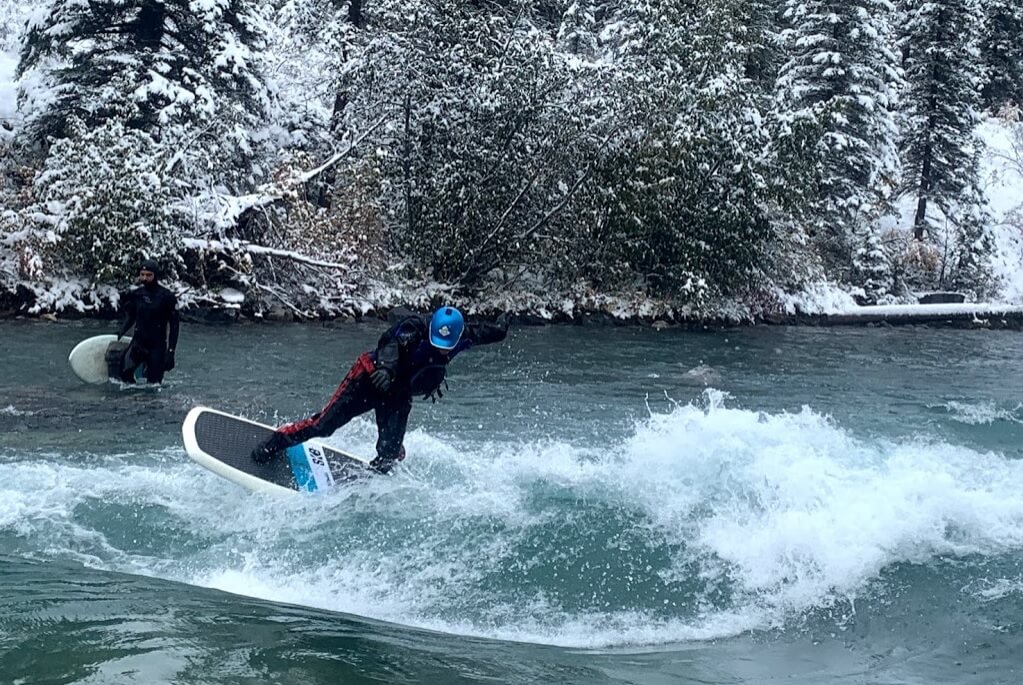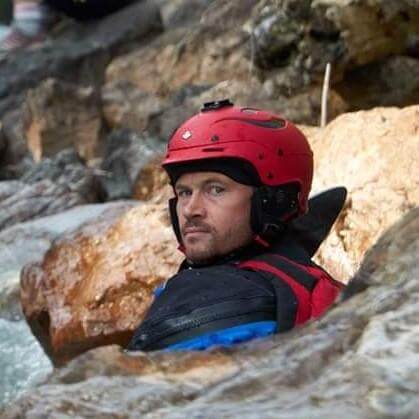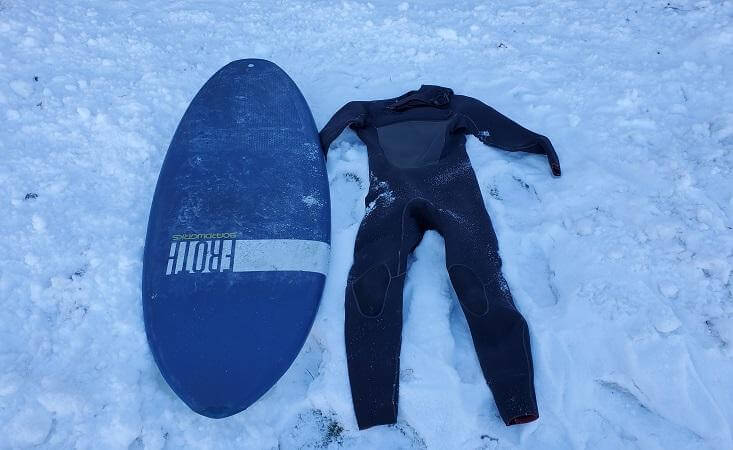What is River Surfing? River surfing has been around since the 1950’s. It’s taken awhile to catch on, but the sport is now gaining momentum and growing in popularity from coast to coast.
For many landlocked Canadians craving that timeless feeling of standing on a wave, river surfing is the only option that doesn’t require a flight to the ocean.
Natural river features produce standing waves which offer up perfect, endless surfing. Many rivers are being modified to produce perfect waves that, in some cases, can be adjusted to accommodate a perfect shape at all levels. Even well-known board shapers are creating new boards specifically for river and static pool waves.
So, what is river surfing? River surfing is simply utilizing a surfboard to maintain a surf on a river wave. The only difference between this and ocean surfing is that when you surf a river wave, you stay in one place and aren't pushed to shore.
In the Canadian Rockies there are some well-known waves. Many more are waiting to be discovered. The Alberta River Surfing Association and Surf Anywhere are proposing major projects to build new features and improve existing ones.
Why Should You River Surf?
For many landlocked Canadians, the dream of surfing perfect waves used to be just that: a dream. But in recent years the growing consciousness of river surfing has changed this dream into reality.
Those who used to only get the occasional surf trip, or never had the opportunity to learn, can now catch waves right in the centre of their hometown. The captivating lifestyle, art forms, and culture are also shared with the river surf community.
There are many reasons to give river surfing a go, but here are a few of the most common ones:
- It’s incredibly fun!
- Challenge yourself with something new
- Improve your surf technique and fitness for your next coastal trip
- Join an active community that is open to new river users
- Experienced surfers can hit the reset button and re-learn a whole new way to surf
What Do You Need for River Surfing?
Ideal gear is determined by the river feature, weather, and water temperature.
In the Rockies, AQ Outdoors recommends the following pieces to get you started river surfing:
1. Board
The ideal starter river surfboard is a high volume shortboard. There are many options, but we suggest a soft top or foam board. These are generally less expensive than epoxy boards and are less likely to be damaged from impact with rocks, the river bottom, and your body. They are typically higher volume, which makes learning easier and keeps you on the surface when paddling into a wave.
- The higher the volume, the easier it is to learn, but you may find you’ll want something with a bit lower volume as you progress.
- Small features like the 10th St. wave in Calgary may require a higher volume board to stay on the wave or maintain speed.
- While many experienced river surfers gravitate toward twin fins or 2+1 setups, a thruster or quad fin setup helps the board feel more predictable while learning.
2. Wetsuit
A 4/3 full wetsuit is the ideal thickness for our cold water for most of the season.
A good quality wetsuit not only keeps you warm, but also provides impact protection and some buoyancy to help keep you on the surface.
3. PFD
The safest place to be in the river is on the surface. A PFD will not only keep you on the surface, but will make swimming for your board easier, provide additional impact protection, and help keep your core warm.
4. Helmet
The river is an unpredictable environment, so expect you and your board to end up in all sorts of unusual positions. Even foam board impacts can hurt and present a potential danger to your head.
Other Gear
-
Booties: Minimum of 2mm Neoprene, 5mm for all around use, or 7mm for winter/spring/fall
-
Gloves or Mitts: 3mm for cold or windy days, 5-7mm for winter/spring/fall
-
Hood: 2-3mm full hood for winter/spring/fall
-
Impact Vest: Provides low volume impact protection and some additional swimming aid but are not coast guard approved. *Impact Vests will not keep an unconscious swimmer afloat.*
-
Soft Flex Fins: Prevent cuts and potential damage to yourself, your wetsuit, and your board. FCS / FCS II
Leashes
Standard ankle leashes are not used for river surfing.
For many surf waves with low risk to swimmers, it is recommended not to use any leash.
However, there are areas where maintaining a connection to your board is vital to your safety and the safety of others.
This is the case where waves do not have good eddy access or there are large rapid rapids below the wave feature where the buoyancy of your board is needed for swimming, or where an unleashed board may be a hazard to other downstream river users. In these circumstances a releasable leash system can be used.
In many rivers it is not unusual for rope, or a surfboard, to get wedged or wrapped around underwater rocks. If your leash is not releasable the rushing river water pushes you downstream, under water, and makes it extremely difficult to release your ankle strap.
There are a few forms of releasable leash:
- Releasable belt - Worn around the waist. These can be an all-in-one system or a two-part system.
- Releasable leash with locking carabiner – To be attached to a PFD
- Other river surf leashes do exist but may still present substantial risks to the user. It is recommended that any releasable leash should not attach to the surfer anywhere lower than your waist.
Where Can You River Surf in the Canadian Rockies?
In the Canadian Rockies the length of the river surfing season is determined by gear, ambition, and a bit of luck, but it is possible to surf year-round.
Most river waves have an ideal range, determined by water level or flow rate. This is generally measured by river height or cubic metres per second (cms). Some waves are only surfable at certain times of the year while others can be surfed year-round. The following waves are a few of the most commonly surfed waves, along with advice regarding flow and recommended skill level.
Waves
10th St. Wave – Calgary, Alberta
This feature is a go-to river surfing spot for beginners and those looking to get into river surfing for the first time. It’s also a great spot for Calgarians to get out for a quick morning or after work session. This wave features easy access, relatively warm water (in comparison to other river waves in the area), a deep pool, and quick access back into the eddy.
The 10th St. wave formed after the Calgary floods in 2013 and has been changing each year as rocks and sediment continue to shift and change the profile of the banks and river bottom. The following info is based on historic averages and may not be 100% accurate as the river continues to shift.
- Ideal flows are generally early spring before run off (April -May) or mid-late summer (July - September).
- Surfable flows range from 50 cms to 180 cms.
- 2020 saw significant changes to the 10th St. wave and surfable flows may differ significantly in future seasons.
- Ideal board – High volume (30+ litre) short board under 5’8”
- Wetsuit – 3/2 or 4/3 depending on time of year
- Unique hazards to this area include city runoff and potential river debris. Watch for glass, needles, and sub-surface hazards which may have been discarded in the river.

Harvey Passage – Calgary, Alberta
The Harvey Passage project was developed as a recreational whitewater park primarily for kayaks, canoes, and rafts. While there were no features specifically built for river surfing, there are a few waves which are surfable. This is another low hazard area to learn the basics of river surf and a good spot for a lesson or first outing.
Harvey Passage is broken into two channels. The South channel (River Right) is the beginner friendly channel with 2 to 3 waves which can be surfed at various flows. The North channel (River Left) is a large volume Class III+ channel and should be considered Expert Only. The waves on this channel are unlikely to be surfable without specific gear and ideal flows.
- Ideal flows are still unknown but generally there are surfable features on the South channel anytime from May to September. The river flow is diverted away from the South channel at the end of October until spring.
- Best surf features are the bottom 2 waves on the South channel
- Longer boards can be used here due to the flat nature of the waves
- High volume boards under 9 ft. work best
- Wetsuit – 3/2 or 4/3 depending on time of year
- Unique hazards include hard concrete bed surface, high traffic, pool toys, and city runoff
- Keep an eye upstream for swimmers and river floaters.

Mountain Wave – Kananaskis, Alberta
The mountain wave on the Kananaskis river was developed by the Alberta River Surfing Association and Surf Anywhere to be Canada’s first man-made river surfing specific feature. This river is dam controlled and flows can change dramatically based on the needs of the Trans Alta power generating station at Barrier Lake.
The Mountain Wave exists year-round, but hour of operation changes seasonally.
This wave is an advanced river surfing wave. There is substantially higher risk of injury due to the increased power of the river, colder water temperatures, shallower run out, and presence of large boulders and other subsurface hazards. Eddy access is good, but the river moves much quicker than the previously mentioned locations. The risk of a long swim should be considered.
- Flows are ideal from 25 – 35 cms
- Check Trans Alta flow times (Barrier Lake)
- Ideal Board – Shortboard under 5’10”
- While more volume makes learning and pop-ups easier, this wave does not require a high-volume board.
- Wetsuit - 4/3 for the majority of year, or 5/4 hooded suit for the winter season
- Unique Hazards include shallow river bed, rocks and boulders, cold water, rafts and other river users.
River Surfing in Canada
So that’s our basic introduction to river surfing in Canada. We’ll produce new articles about everything river surfing to get you setup with all the knowledge and information you need to for this exciting and growing Canadian sport.
Related Surfing Articles
River Surfing Safety | Complete Guide
Best River Surfboards | Complete Guide
Written by Tom
Tom grew up riding every kind of board in Ontario. He started taking surf trips, both internationally and on the Canadian coast, once he moved out West. Being able to river surf year round is a huge benefit of living close to the Kananaskis River. Now, river surfing is his main summer activity alongside whitewater kayaking and climbing.
AQ Outdoors stocks everything river surfing. If you have questions about what you need or anything about the products we carry, feel free to contact us below.
Edmonton: (p) 780 463-4892 (e) info@aquabaticsedmonton.com
Calgary: (p) 403 288-9283 (e) info@aqoutdoors.com





